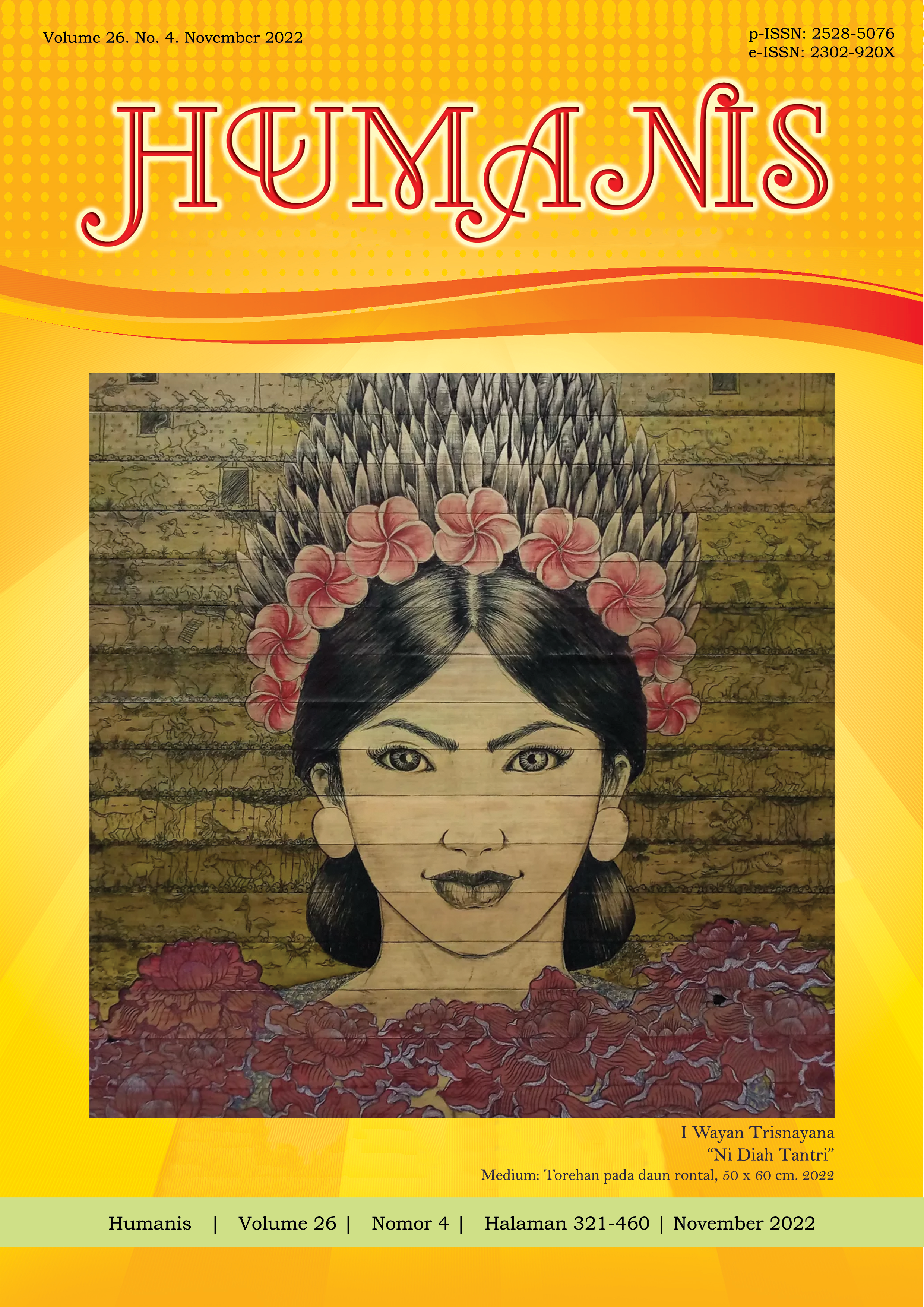Investigating Women’s Representation and Identity in Tourism Context Using Narration: A Perspective from Bali
Abstract
The present study discussed the representation and identity of three selected women figures who contributed to the development of tourism in Bali and worked as a team leader, an entrepreneur, and an influencer, respectively. This study has two objectives: 1. to find out how women represent themselves and 2) to find out how women build their identity in the tourism context using narration. The authors used narrative inquiry to collect valuable stories from the informants. Using narrative inquiry, the stories produced by the informants were unique and meaningful. The study’s results revealed that women represented themselves as figures responsible for fulfilling domestic, i.e. family, and non-domestic roles, i.e. careers. The study also revealed that they still embraced traditional and domestic roles as their identity while simultaneously managing to actualise themselves in their careers. Keywords: identity, gender, narrative inquiry, women’s representation, women’s language
Downloads
References
Apte, M. L. (2001). Language in Society: Overview. In R. Mesthrie (Ed.), Concise Encyclopedia of Sociolinguistics (pp. 36–48). Elsevier.
Bucholtz, M. (2011). White Kids: Language, Race and Styles of Youth Identity. Cambridge University Press.
Coupland, N. (2001). Introduction: Sociolinguistic theory and social theory. In N. Coupland, S. Sarangi, & C. N. Candlin (Eds.), Sociolinguistics and Social Theory (pp. 1–26). Pearson Education Limited.
Eckert, P., & McConnell-Ginet, S. (2003). Language and Gender. Cambridge University Press.
Edwards, D. (2006). Discourse, cognition and social practices: The rich surface of language and social interaction. Discourse Studies, 8(1), 41–49. https://doi.org/10.1177/1461445606059551
Fairclough, N. (1992). Discourse and Social Change. Polity Press. https://doi.org/10.2307/2074659
Fought, C. (2006). Language and Ethnicity: Key Topics in Sociolinguistics. Cambridge University Press.
Georgakopoulou, A. (2006). The Other Side of the Story: Towards a Narrative Analysis of Narratives-in-Interaction. Discourse Studies, 8(2), 235–257.
Hollway, W., & Jefferson, T. (2000). Doing Qualitative Research Differently: Free Association, Narrative and the Interview Method. Sage Publications Ltd. https://doi.org/10.1007/s10038-006-0368-7
Holmes, J. (2004). Power, Lady, and Linguistic Politeness in Language and Women’s Place. In M. Bucholtz (Ed.), Language and Women’s Place: Text and Commentaries (pp. 77–102). Oxford University Press.
Holmes, J. (2006). Gendered Talk at Work: Constructing Social Identity Through Workplace Interaction (J. Coates, J. Cheshire, & E. Reid (eds.)). Blackwell Publishing. https://doi.org/10.1002/9780470754863
Kumala Pratiwi, L. P. A. (2016). Motivasi Perempuan Membuka Usaha Sektor Informal Di Daya Tarik Wisata Tanah Lot, Tabanan. Jurnal Master Pariwisata (JUMPA), 3, 115–126. https://doi.org/10.24843/jumpa.2016.v03.i01.p08
Labov, W. (1990). The intersection of sex and social class in the course of linguistic change. Language Variation and Change, 2(2), 205–254. https://doi.org/10.1017/S0954394500000338
Lakoff, R. (1973). Language and Woman’s Place. Language in Society, 2(1), 45–80. https://doi.org/10.2307/4166707
Mahboob, A., Djenar, D. N., & Cruickshank, K. (2015). Identity and mode as a frame for understanding social meanings. In R. J. Watts & D. Britain (Eds.), Language and Identity across Modes of Communication (pp. 20–41). De Gruyter Mourton.
Omoniyi, T. (2006). Hierarchy of Identities. In T. Omoniyi & G. White (Eds.), Sociolinguistics of Identity (pp. 11–33). Continuum.
Otsuji, E. (2010). “Where Am I From”: Performative and “Metro” Perspectives of Origin. In D. Nunan & J. Choi (Eds.), Language and Culture: Reflective Narratives and the Emergence of Identity (pp. 186–193). Routledge. https://doi.org/10.1016/j.langcom.2003.11.001
Ottino, A. (2006). Revisiting kinship in bali: Core-lines and the emergence of elites in commoner groups. The Asia Pacific Journal of Anthropology, 4(1–2), 25–53.
Praminatih, G. A. (2021). Shifting Speech Levels: Exploring Balinese Women’s Language in Inter-Caste Marriage Communication Contexts. Jurnal Kajian Bali (Journal of Bali Studies), 11(1), 61–76.
Putra, I. N. D. (2007). Wanita Bali Tempo Doeloe: Perspektif Masa Kini. Pustaka Larasan.
Putra, I. N. D. (2014). Empat Srikandi Kuliner Bali: Peran Perempuan Dalam Pembangunan Pariwisata Berkelanjutan. Jurnal Master Pariwisata (JUMPA), 01, 65–94.
Putra, I. N. D. (2020). Segara Giri: Kontribusi Perempuan dalam Pariwisata Bali. Pustaka Larasan.
Sartini, N. W. (2020). Ekspresi Verbal Masyarakat Bali terhadap Kelahiran Bayi: Kajian Linguistik Kebudayaan. Jurnal Kajian Bali, 10(2), 395–416.
Sartini, N. W. (2021). Hambatan yang tak Terasa: Wacana-Wacana Bias Gender dalam Masyarakat Bali Dewasa Ini. In N. P. T. Widanti & I. N. D. Putra (Eds.), Haluan dan Halangan Kesetaraan Gender di Bali. Jagat Langit Sukma.
Spender, D. (1998). Man made language (Second Ed.). Pandora Press.
Tannen, D. (1991). You Just Don’t Understand. In Public Relations Review. Ballantine Books. https://doi.org/10.1016/0363-8111(91)90045-m
Trudgill, P. (2000). Sociolinguistics: An introduction to language and society (D. Crystal (ed.); Fourth Ed). Penguin Books. https://doi.org/10.2307/326846
Van Dijk, T. A. (1993). Principles of critical discourse analysis. Discourse & Society, 4(2), 249–283. https://doi.org/10.1177/0957926593004002006
Wardhaugh, R. (2006). An Introduction to Sociolinguistics (Fifth Ed). Blackwell Publishing. https://doi.org/10.1353/lan.2003.0268
Wertz, F. J., Charmaz, K., McMullen, L. M., Josselson, R., Anderson, R., & McSpadden, E. (2011). Five Ways of Doing Qualitative Analysis: Phenomenological Psychology, Grounded Theory, Discourse Analysis, Narrative Research, and Intuitive Inquiry (First Ed). The Guilford Press.
Widiastuti, A. N. (2018). Perempuan dalam Iklan Pariwisata Indonesia. Mediator: Jurnal Komunikasi, 11(2), 214–226. https://doi.org/10.29313/mediator.v11i2.3836


















